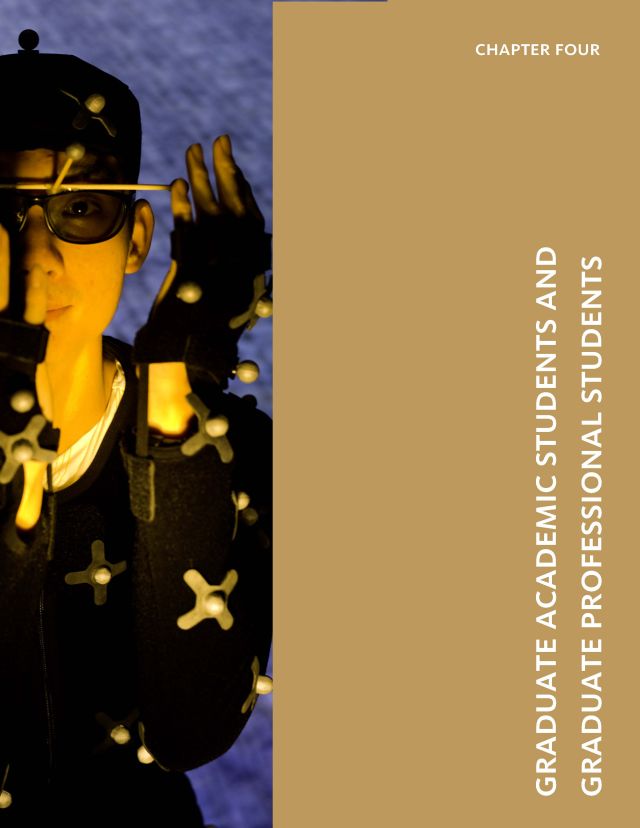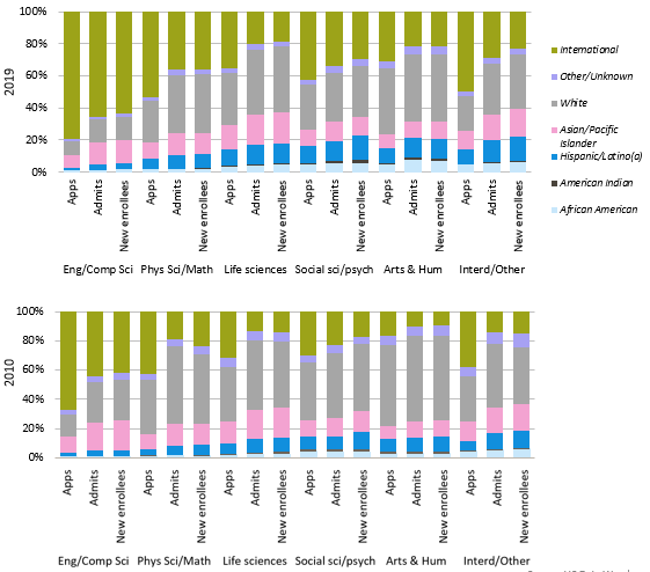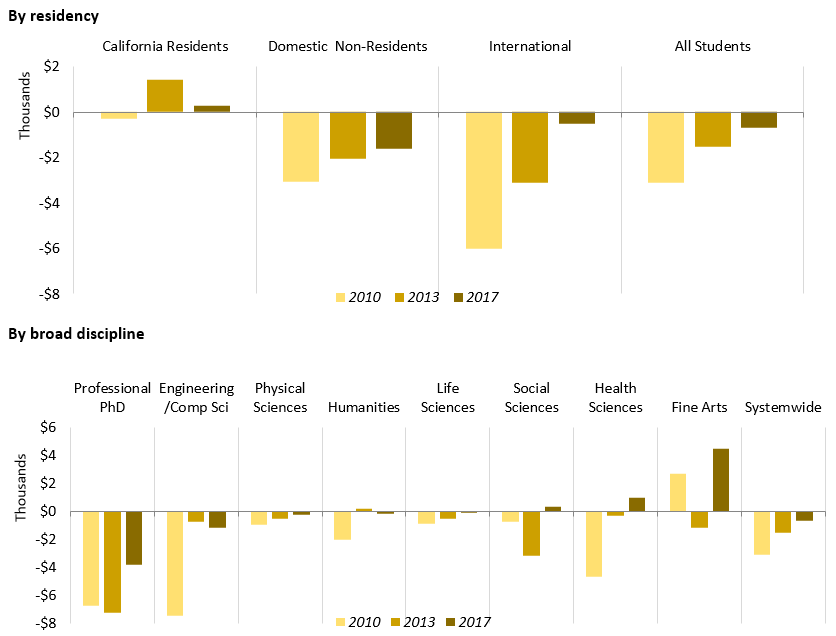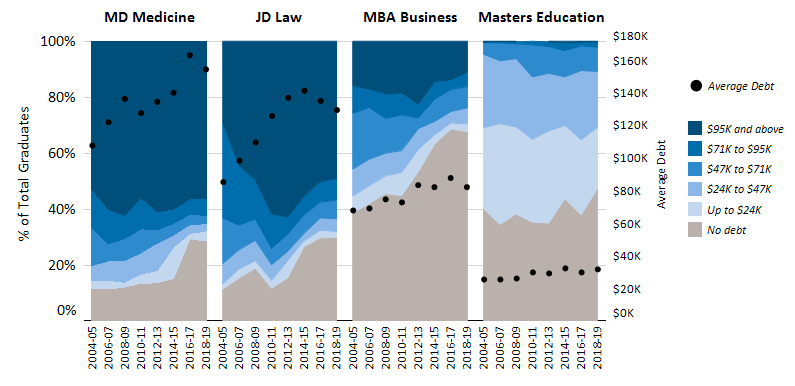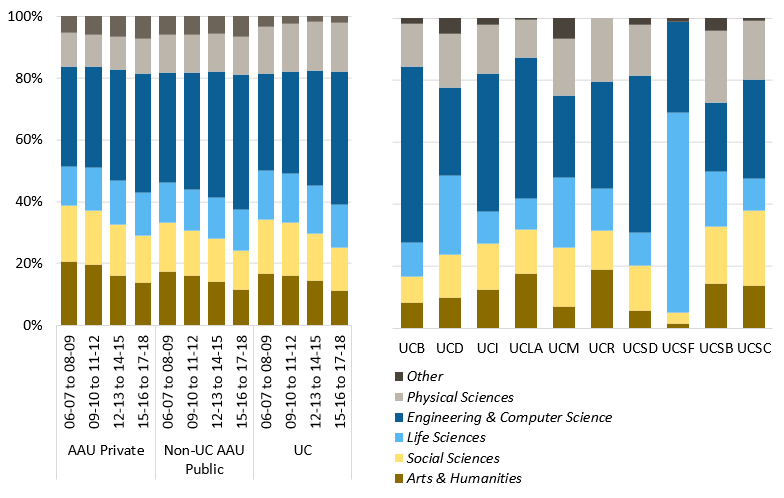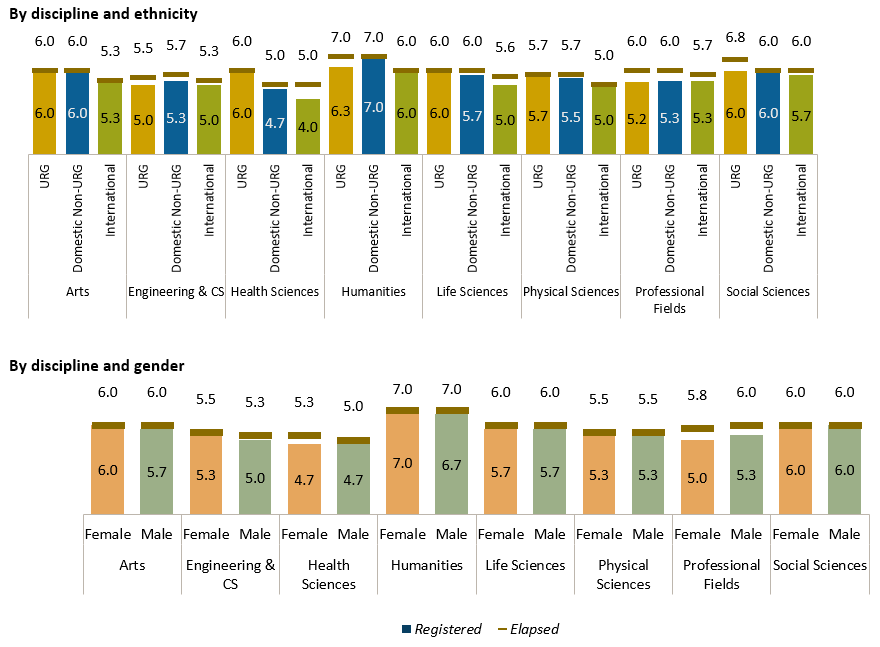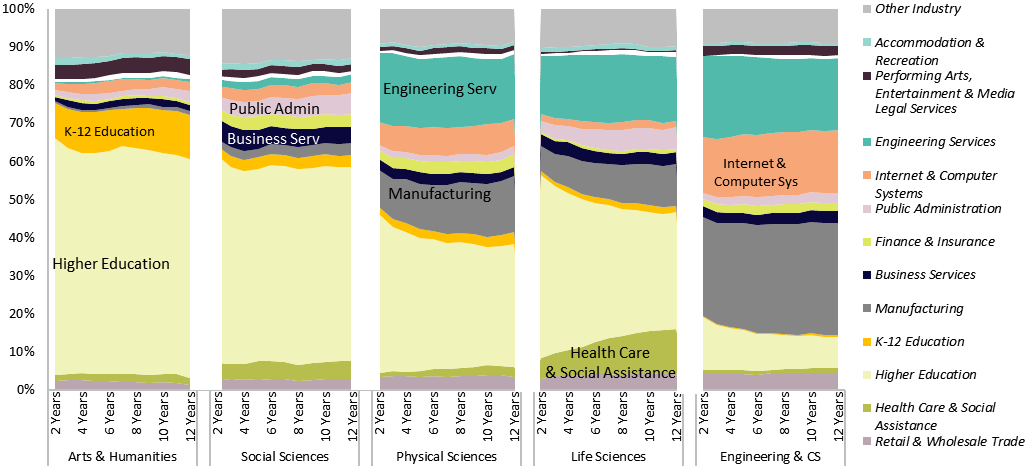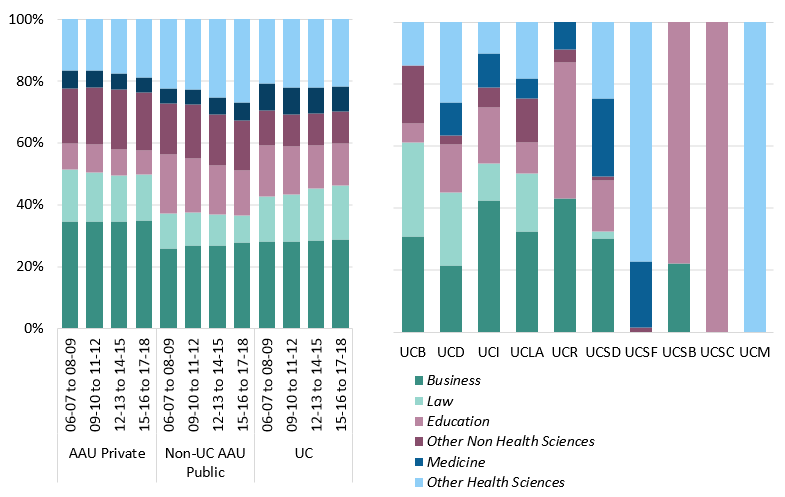Goals
California’s Master Plan for Higher Education gives the University of California the responsibility of enrolling and preparing graduate academic and professional students to help meet the needs of California and the nation, and to further the UC mission of teaching, research, and public service. Thus, reviving adequate support for the University of California is important, as its graduate education enterprise fuels California’s role as a national and international leader.
UC’s goals for graduate education are to offer outstanding degree programs, advance research, support undergraduate instruction, and prepare students to join a professional workforce. UC produces the leaders of the future — the teachers, artists, thinkers, innovators, scientists, inventors, doctors, lawyers, and nurses; and it creates an environment of exploration and discovery that stimulates innovation and invention. UC’s internationally renowned graduate education enterprise serves to drive California’s economy and its role as a global leader. UC graduate education allows California to grow, create jobs, and offer its residents the standard of living for which the state is well known.
Types of graduate degrees
UC awards both graduate academic degrees and graduate professional degrees.
Graduate academic degrees — These include academic doctoral and academic master’s degrees in education, physical sciences, social sciences, arts, humanities, and engineering/computer science. The largest proportion of graduate academic degrees awarded at UC is in the STEM fields — science, technology, engineering, and mathematics. From the 2016–17 to 2018–19 academic years, more than 70 percent of UC graduate academic degrees were awarded in STEM fields.
Graduate professional degrees — UC’s professional degrees include professional master’s and professional practice degrees in fields such as law, medicine, nursing, business, education, architecture, public policy, and the arts. The graduate professional category includes professional master’s degrees (e.g., M.B.A., M.Ed.) and professional practice degrees (e.g., J.D., M.D.). In the field of medicine, UC offers the nation’s largest instructional program in health care and health sciences.
The University maintains multiple funding models for its graduate professional programs. Many state-supported programs (e.g., M.B.A., law, medicine) assess professional degree supplemental tuition (PDST), which allows the professional schools to ensure their excellence, accessibility, and inclusiveness, and assists with affordability (by requiring return-to-aid for tuition revenue). Programs assessing PDST commit substantial resources to student financial support, including grants and scholarships. Since PDST began in 1994, both the number of professional degree programs that charge PDST and the amount charged have increased.
Other UC graduate professional programs, primarily master’s programs, follow a self-supporting funding model. The largest are business and management programs. These programs receive no state support and are funded entirely by revenues generated by the program and other non-state revenues. Self-supporting programs allow the University to serve additional students beyond those supported through state resources. They also fulfill higher education and workforce needs. Some self-supporting programs serve nontraditional populations such as full-time employees, mid-career professionals, and international students with specialized goals. Many programs are offered through an alternative mode of delivery, such as online or hybrid instruction, alternative scheduling, or at off-campus locations.
Graduate enrollment share
UC’s graduate education enterprise enrolls over 59,000 students, with doctoral students representing the largest number (28,400), and professional (22,000) and master’s (8,000) comprising the remainder. Despite its size, UC’s graduate education enterprise represents a smaller share of its total enrollment than that of its peers. Graduate students comprise 21 percent of total student enrollment at UC, which is lower than the proportion of graduate enrollment among other Association of American Universities public (27 percent) and private (56 percent) peer institutions. In addition, while the graduate share of UC’s total enrollment has remained relatively constant over the last decade at 21 percent, the doctoral enrollment percentage has declined. The graduate professional percentage has risen steadily (4.2.1). Despite these enrollment trends, UC research degree production is comparable to other public university competitors. For example, in number of research degrees produced and percentage of research degrees produced in comparison to other types of degrees, UC compares favorably to its competitors. While enrollment needs will vary by program, it is important that academic doctoral student enrollment be supported at sufficient levels to drive UC’s research enterprise and support faculty innovation.
UC is proposing a multi-year framework that seeks to improve degree attainment and produce 200,000 more degrees through 2030, in addition to the projected one million degrees. About 12 percent of these additional degrees (over 25,000) would be at the graduate level.
Supporting diverse career paths and making research accessible
To promote and highlight the work of master’s and doctoral students across UC campuses, UC holds an annual research communication competition called UC Grad Slam. The event challenges its ten participants — the winners of each campus’s Grad Slam — to distill years of academic research into a three-minute presentation free of technical lingo. Grad Slam encourages students to communicate their research in a clear and compelling way to non-specialists — a skill that employers need and value. Campuses provide workshops and resources for students to develop this skill set. The contest also demonstrates to the public that UC research benefits their lives in both ordinary and quite extraordinary ways. UC unfortunately had to cancel the 2020 installment of systemwide Grad Slam due to the coronavirus pandemic. Four UC campuses had already held their own Grad Slam contests and nominated finalists in topics including using insects to find a cure for cancer, exploring the dark corners of the universe, and immunity and microbes.
UC graduate students have also applied their research to make important contributions to the fight against COVID-19. One of the primary symptoms of COVID-19 is difficulty breathing, and approximately one percent of people who contract the virus require ventilators to push air in and out of their lungs and support their recovery. As COVID-19 becomes more widespread, many hospitals have experienced acute shortages of ventilators to treat patients. Along with Drs. James Friend and Lonnie Petersen, UC San Diego graduate students are rapidly developing simple, ready-to-use ventilators through 3-D printing technology.
Career Pathways Survey
In 2017, UC launched the Ph.D. Career Pathways Survey, which is a partnership between the University of California and the Council of Graduate Schools. The survey’s third phase will be conducted in 2020, and its purpose is to better understand the career preparation and pathways of Ph.D. students and alumni. While the Council of Graduate Schools is specifically focused on humanities and STEM Ph.D.’s, the University of California is collecting data from doctoral students and alumni in all disciplines.
Results showed high levels of employment and satisfaction with UC Ph.D. programs. Ninety-two percent of respondents were working in a job for pay, 69 percent indicated they were working in a field closely related to their degree, and 54 percent were employed at a higher education institution. Eighty-eight percent of respondents stated that their Ph.D. training prepared them well for their current job, 76 percent stated that they would pursue a Ph.D. in the same field, and 80 percent indicated they would choose the same institution for their Ph.D. education if given the opportunity to choose again.
Equity and inclusion: Expanding academic pathways
A more diverse community of scholars at all levels has been a longstanding goal for UC, but progress at the doctoral, postdoctoral, and faculty levels has been slow. UC’s difficulties reflect challenges in both enrolling individuals from underrepresented groups in doctoral programs and in attracting and hiring them as postdoctoral scholars and faculty. Systemwide initiatives aimed at increasing the diversity of UC’s academic community include:
UC-Hispanic Serving Institutions Doctoral Diversity Initiative (UC-HSI DDI) — Launched in fall 2019, the UC-HSI DDI aims to improve faculty diversity by enhancing pathways to the professoriate for underrepresented students from California Hispanic Serving Institutions (HSIs). The UC-HSI DDI includes two components: 1) competitive grant awards to UC faculty/faculty administrators to support short-term and long-term programs/projects to enhance and expand pathways to the professoriate for underrepresented students; and 2) funding to directly support graduate student preparation for the professoriate. Funding includes resources to support a limited number of Ph.D. students, named UC President’s Pre-Professoriate Fellows, who are California HSI alumni and have advanced to candidacy at UC. The UC President’s Pre-Professoriate Fellowship fosters their interest in and preparation for the professoriate. Additional professional development support for underrepresented Ph.D. students is provided to encourage and help equip them to consider careers in the professoriate. Another goal of the UC-HSI DDI is to enhance the climate of academic programs through interventions, incentives, and efforts that foster an academic culture of inclusion and equity — especially for faculty and students from underrepresented communities.
UC LEADS — The University of California Leadership Excellence through Advanced DegreeS (UC LEADS) program prepares promising UC undergraduate students for advanced education in science, technology, engineering, and mathematics (STEM) fields. The program prepares underrepresented UC undergraduate students for doctoral education opportunities at a UC campus. From its inception in 2000–01 through 2018–19, 1,061 scholars participated in UC LEADS. Of the 932 Scholars who have graduated with their undergraduate degree, 676 (73 percent) are either currently enrolled in graduate school or have already earned degrees in a master’s or doctoral program. Given the importance of gender and ethnic equity within STEM-based doctoral programs, it is notable that 50.3 percent are women, 53 percent are first-generation college students, and 52 percent are from underrepresented minority groups. Thirty-five UC LEADS alumni are tenure-track faculty, including eight at UC.
UC-HBCU Initiative — The University of California-Historically Black Colleges and Universities (UC-HBCU) Initiative was established to increase the number of African Americans completing Ph.D.’s at UC by investing in relationships between UC faculty and HBCUs. The program has raised UC’s profile within the HBCU community and facilitated faculty research collaborations in addition to enrolling and retaining students.
University of California President’s Postdoctoral Fellowship Program (PPFP) — The PPFP was established to encourage outstanding women and minority Ph.D. recipients to pursue academic careers at UC. The program offers postdoctoral research fellowships, professional development, and faculty mentoring to outstanding scholars in all fields whose research, teaching, and service will contribute to diversity and equal opportunity at UC. More information about the PPFP is presented in Chapter 5.
Looking ahead
The University continues to develop programs to enhance the graduate student experience. UC’s overall excellence rests on the strength and scope of its graduate programs. Unlike undergraduate enrollment planning, which is based on California’s Master Plan, graduate enrollment planning includes the assessment of state and national needs, faculty expertise, program quality (which includes international competitiveness), and financial support. In early 2018, Provost Michael Brown convened a workgroup on graduate education, which examined the current condition and needs of UC’s academic doctoral education enterprise. The workgroup, a subcommittee of the Academic Planning Council, focused on the urgent need for significantly greater investment in academic doctoral education. This need, due to long-term underinvestment, has now reached a critical point; UC’s research excellence, impact, and dominance cannot be maintained without improved support. The workgroup examined key areas of importance within graduate education, such as providing multi-year guaranteed funding packages upon admission, improving student stipend amounts, prioritizing mental health and well-being, improving diversity and inclusion, and enhancing professional development support. The workgroup issued its final report in 2019, urgently stressing that without adequate support for doctoral education, UC risks its excellence and continued role as a key contributor to California’s economy and as a global leader in research.
As with undergraduate students, UC’s graduate students are experiencing challenges with basic needs. In 2015, 25 percent of graduate students reported low food security and four percent reported homelessness. UC is currently collecting information to help assess food insecurity and homelessness, and in a future UC graduate student survey, UC will be institutionalizing these items, including housing insecurity, to help understand how to best meet graduate students basic needs.
The effects of long-term inadequate support for students have recently resulted in systemwide Teaching Assistant wildcat strikes and graduate student cost-of-living protests. These issues continue to be challenging. However, some progress is being made. UC Irvine has guaranteed five years of funding support for doctoral admits since 2016. UC Santa Cruz announced this commitment in 2019, and UC San Diego and UC Berkeley are committed to offering this support in the near future. The remaining campuses continue to examine this matter. These commitments let students know they will have guaranteed funding support (in various forms, including fellowship, graduate student researcher appointment, and/or teaching assistantship) for five years or for the normative time to complete their degree (if less than five years). The assurance that they will be funded each year can help reduce some of the financial stress students face. In an effort to help mitigate financial concerns and better support doctoral students, several campuses are also offering various forms of cost-of-living or housing supplements.
As part of the University of California’s multi-year framework, UC’s goal is to grow 200,000 more degrees (on top of the one million projected) by 2030. Of those, 40,000 are expected to be graduate degrees, which will help UC meet critical workforce needs, along with helping UC expand the pathway to graduate education for the new generation of students – that is, California’s Pell, first-generation and underrepresented students. UC needs to be able to grow graduate enrollment to achieve this goal and UC’s success would increase graduate student diversity to better reflect California and expand availability pools for future UC and other university faculty.
For more information

